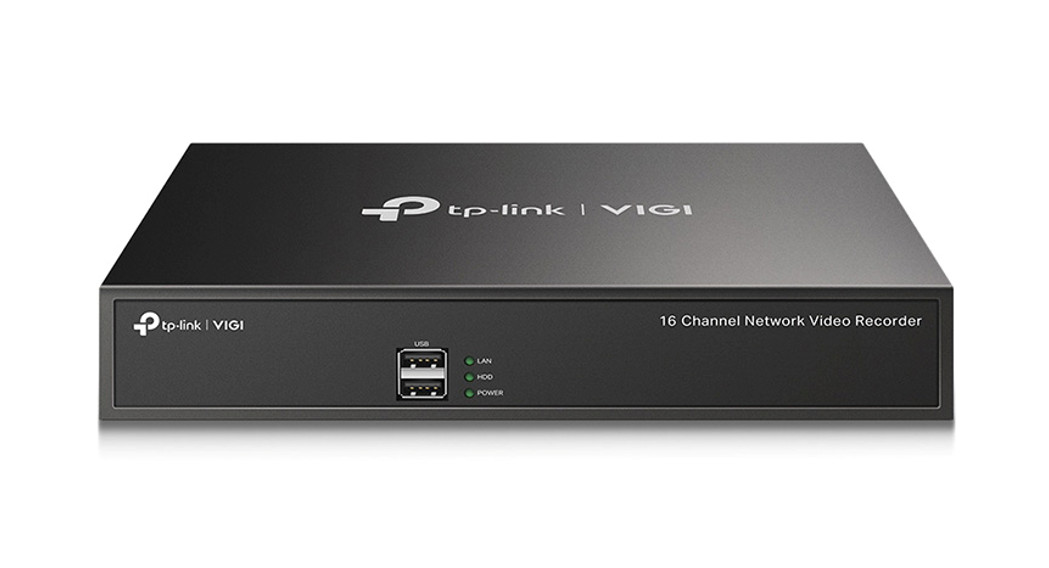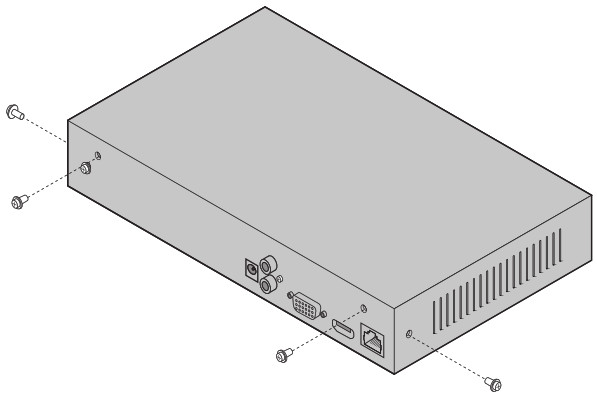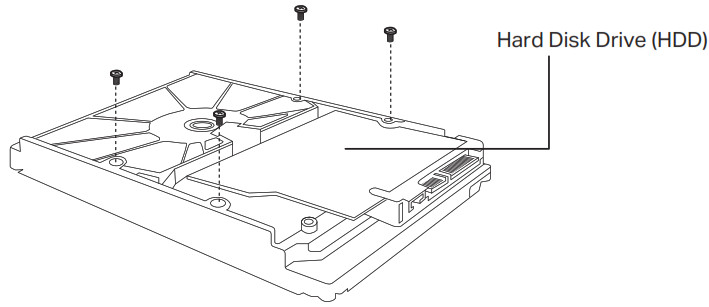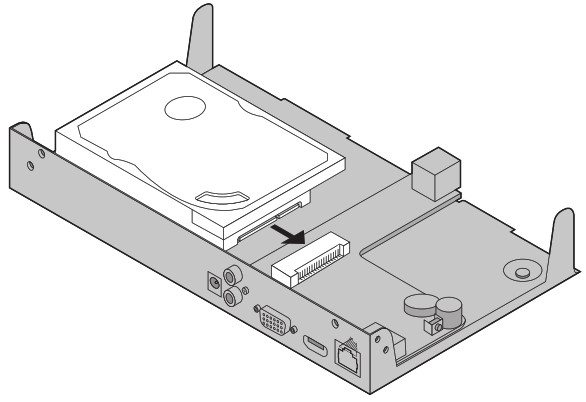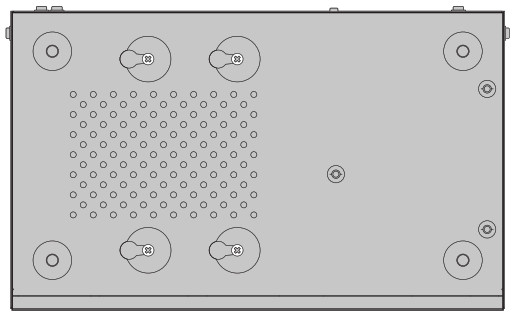 Quick Installation GuideNetwork Video Recorder*Images may differ from actual products.
Quick Installation GuideNetwork Video Recorder*Images may differ from actual products.
Package Contents
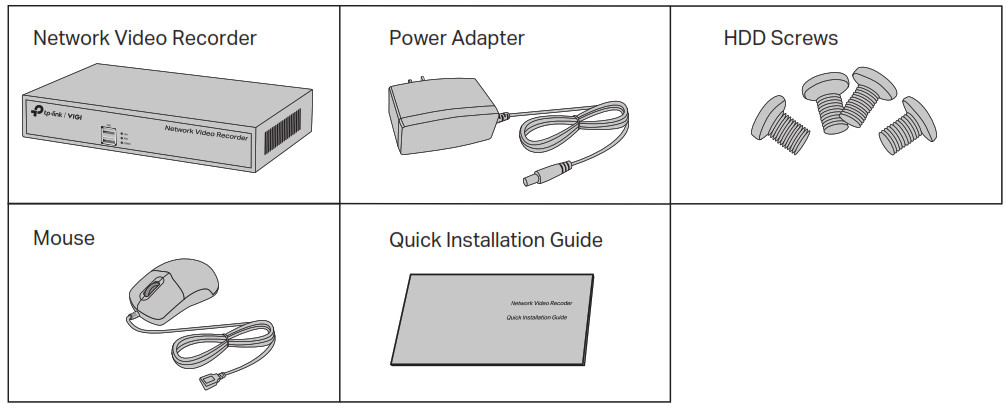
Product Overview
Front Panel
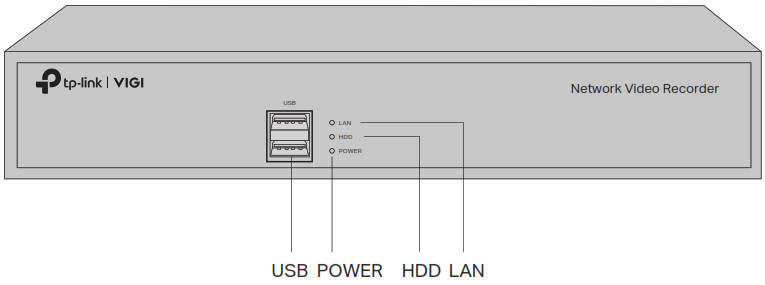
| Indicator | Name | Stalin | Description |
| LAN | Network StatusIndicator | On | Network is working properly. |
| Flashing | Data Is being transmitted or received. | ||
| Off | The network Is malfunctioning. | ||
| HDD | Hard Disk DriveIndicator | On | The HDD Is normal. |
| Off | No HDD or the HDD is malfunctioning. | ||
| POWER | Power StatusIndicator | On | The NVR is powered on. |
| Off | The NVR is powered off. |
Back Panel
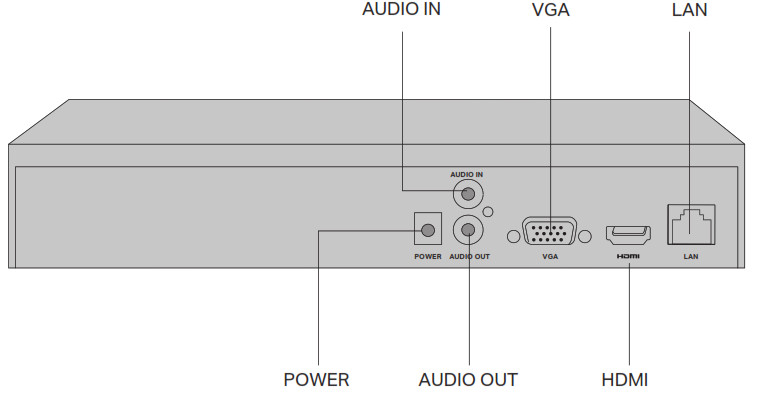
| Interface | Description |
| USB(Front Panel) | 2 USB ports for additional devices such as USB mouse, USB storage device. and USB keyboard. |
| POWER | Connector for power input. |
| AUDIO IN / AUDIO OUT | Connector for audio input and output.Note: Audio input only supports microphones with a power supply. |
| VGA | Output port for analog video signals.Connect your monitor to this port if it uses a VGA connection. |
| HDMI | Output port for high-definition audio and video signals. Connect your monitor to this port if it uses an HDMI connection. |
| LAN | RJ45 10/100Mbps self-adaptive Ethernet port Connect to an Ethernet device (eg. router and switch). |
Hard Drive Installation
For the first-time installation, please prepare a 3.5-inch hard disk drive (HDD). It is recommended to use the HDD of surveillance or enterprise level. Before installation, please disconnect the power from the network video recorder (NVR).
- Remove the fixing screws on the side and back panels to open the cover of the NVR.

- Attach the 4 included HDD screws to your hard drive. Do not fasten.

- Match the 4 screws on the HDD with the 4 holes on the NVR, and insert the HDD interface into the slot.

- Flip the NVR upside down and fasten the HDD screws. Replace the cover and fasten the screws of the NVR.

Hardware Connection
Follow the steps below to complete the hardware connection.
- Connect your monitor to the HDMI or VGA port according to the connection port it supports.
- Connect your monitor to a power source and turn it on.
- Connect the LAN port of the NVR to a network device with an Ethernet cable.
- Connect the provided USB Mouse to the USB Interface of the NVR (front panel).
- Connect the power adapter to the NVR.
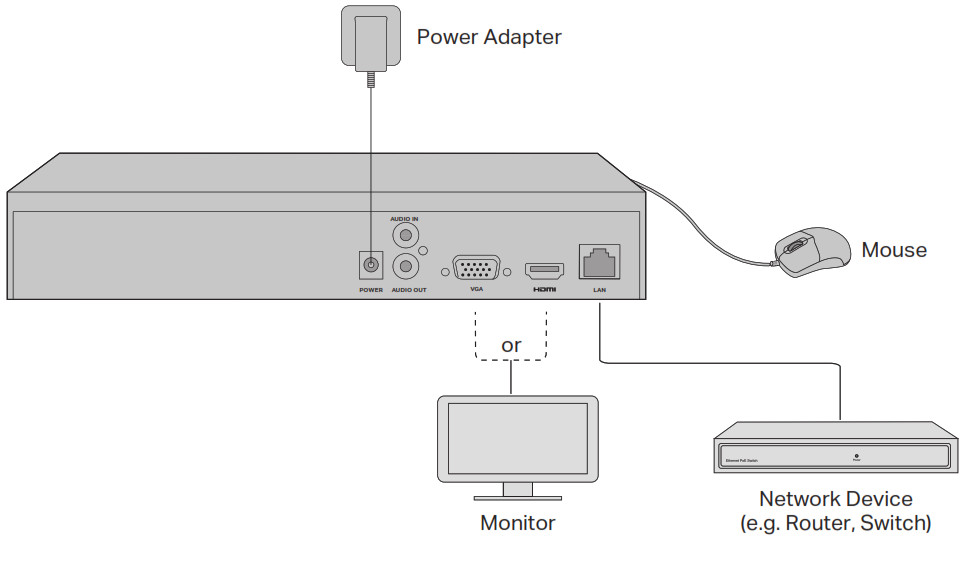
Cautions
- If you want to turn off the NVR after installing the hard drive, right-click on the Live View screen and click the Power button on the Main Menu of your monitor. Do not unplug it directly.
- The input voltage should match the power requirements of the NVR.
- The buzzer on the NVR may be triggered when no hard drive is installed or the hard drive in the NVR hasn’t been initialized. You can turn it off in Event-Exception Detection-Disk Exception.
Configuration
NVR can add and manage cameras in batches.* Here we use TP-Link cameras as an example. For other camera brands, please refer to their User Manuals to add the cameras.

Step 1. Connect your cameras to the same network as your NVR.Step 2. Follow the instructions to finish Quick Setup.
- Create a login password for the NVR and a preset password for your unset cameras.Note: Enter an email address for resetting the password of NVR or cameras.
- Enable Plug and Play and the NVR will automatically find and add the cameras in your network.
- Follow Quick Setup to complete the settings of the NVR.
Step 3. Right-click on the Live View screen to open the Main Menu for management.(Optional) Step 4. Bind your NVR to a TP-Link ID for remote access and management.
- Right-click on the Live View screen and click Settings.
- Click Cloud Services on the top, enter your TP-Link ID and password and click Bind.
More Management MethodsYou can add and manage your devices via any of the methods below.
Method 1: Via the VIGI Security Manager (Windows only)View live video and modify NVR settings on your computer.
- Download the VIGI Security Manager on your computer at https://www.tp-link.com/support/download/vigi-security-manager/.
- Install the VIGI Security Manager and open it.
- NVR on the same network as your computer can be automatically discovered. Go to Settings > Discovered Devices, click Add, and follow the instructions to add your NVR.
Frequently Asked QuestionsQ1. What should I do if I forget the login password of my NVR?A1. Click Forgot Password on the login page and then follow the instructions to reset the password.A2. Remove the cover, then press and hold the Reset button inside the NVR for over 3 seconds. The NVR will restore to the factory settings. Then follow Quick Setup to create a log in password.
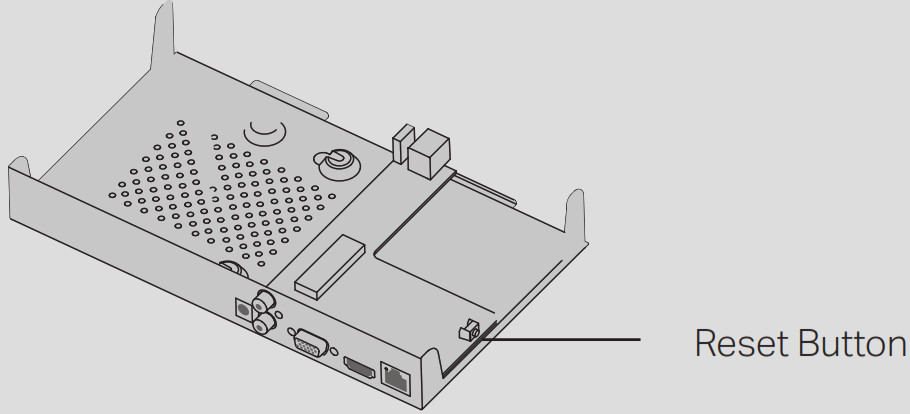 Q2. What can I do if no cameras are found?A1. Refresh to discover your cameras again.A2. Make sure the cameras are powered on.A3. Make sure your cameras and NVR or computer are in the same network.A4. Try to add your cameras manually.Q3. What can I do if my NVR fails to connect to the Internet?A1. Check if the internet is working properly.A2. Make sure your NVR is in the same network segment as your network devices, or select Auto as the mode to configure the NVR to obtain a dynamic IP address. For more details, please refer to the NVR’s User Guide.If you have more questions, please visit https://www.tp-link.com/support/faq/2850/.The terms HDMI, HDMI High-Definition Multimedia Interface, and the HDMI Logo are trademarks or registered trademarks of HDMI Licensing Administrator, Inc.
Q2. What can I do if no cameras are found?A1. Refresh to discover your cameras again.A2. Make sure the cameras are powered on.A3. Make sure your cameras and NVR or computer are in the same network.A4. Try to add your cameras manually.Q3. What can I do if my NVR fails to connect to the Internet?A1. Check if the internet is working properly.A2. Make sure your NVR is in the same network segment as your network devices, or select Auto as the mode to configure the NVR to obtain a dynamic IP address. For more details, please refer to the NVR’s User Guide.If you have more questions, please visit https://www.tp-link.com/support/faq/2850/.The terms HDMI, HDMI High-Definition Multimedia Interface, and the HDMI Logo are trademarks or registered trademarks of HDMI Licensing Administrator, Inc.
![]()
Note:
- Make sure your NVR can get access to the internet before binding.
- If you don’t have a TP-Link ID, sign up first.
- If your NVR fails to connect to the Internet, please refer to FAQ-Q3.
- For more instructions, please refer to the NVR’s User Guide.
- If you want to add a camera after Quick Setup, please follow the steps below:
- Right-click on the Live View screen and click Add Camera.
- Select a camera and click + to add your camera directly. If you have disabled Plug and Play on your NVR, please create a password or use the preset password for your unset camera.
Note:
- The password preset for cameras in Quick Setup will be applied to your unset cameras.
- If your cameras have been activated, use the previous passwords to add and manage the cameras.
- If you can’t find your camera, refer to FAQ-Q2.
Method 2: Via the TP-Link VIGI App
Remotely view live video, manage NVR, and get instant alerts.
- Download and install the TP-Link VIGI app.
 https://www.tp-link.com/app/qrcode/?app=vigi
https://www.tp-link.com/app/qrcode/?app=vigi - Open the app and log in with your TP-Link ID. If you don’t have an account, sign up first.
- Tap the + button on the top right and follow the app instructions to add your NVR.
![]() For technical support, the user guide and other information, please visit https://www.tp-link.com/support, or simply scan the QR code.
For technical support, the user guide and other information, please visit https://www.tp-link.com/support, or simply scan the QR code.![]() To ask questions, find answers, and communicate with TP-Link users or engineers, please visit https://community.tp-link.com to join TP-Link Community.
To ask questions, find answers, and communicate with TP-Link users or engineers, please visit https://community.tp-link.com to join TP-Link Community.![]() If you have any suggestions or needs on the product guides, welcome to email [email protected].
If you have any suggestions or needs on the product guides, welcome to email [email protected].

http://www.tp-link.com/support
References
[xyz-ips snippet=”download-snippet”]

